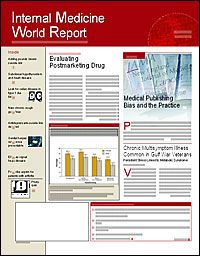Publication
Article
Internal Medicine World Report
From the Institute of Medicine Evaluating Postmarketing Drug Safety
Author(s):
WASHINGTON, DC?Increas?ing concern for the safety of approv?ed prescription drugs is fueling a revision of clinical trial designs and drug surveillance methods, among other changes, reported an expert panel that was recently convened by the Institute of Medicine to assess how to improve postmarketing surveillance and drug safety.
"Drug approval is about balancing safety and efficacy, not about guaranteeing safety," said Lou Garrison, PhD, of the Uni?ver?sity of Washington. "A major difficulty in relating benefits and risks is that they are measured in different units."
This fourth and final meeting lasted several days, one of which was open to the public. It was de?signed to elicit input from academic experts and the medical industry, including the FDA, re?gard?ing the regulation and safety of marketed pharmaceutical products.
In addition to the much-publicized recall of rofecoxib (Vioxx) in September 2004 and valdecoxib (Bextra) in 2005, a total of 13 prescription drugs were withdrawn from the market because of safety concerns between 1997 and 2001; some of these were in widespread use for >=10 years before their removal (Table).
According to Dr Garrison, one of the primary challen?ges in balancing benefits and risks of ap?p?rov?ed pre scription drugs is the frequent need to compare a mod?est benefit that occurs in many patients with a serious adverse event that occurs in relatively few patients.
"The future of pharmacoepidemiology is likely to include systematic screening for adverse drug reactions, pharmacy-based surveillance, and other innovations," said Brian Strom, MD, MPH, of the University of Pennsylvania, Philadelphia. "The use of molecular methods to ?measure an individual's probability of drug response will also likely become more widespread."
Current sources for pharmacoepidemiologic studies include spontaneous case reports of adverse drug reactions (ADRs), population-based data banks, computerized programs, and data ?collected as part of ad hoc studies. Most randomized clinical trials are relatively small and are unlikely to provide the quality of in?formation needed to ensure drug safety after app?ro?val, Dr Strom noted.
"Adverse drug events are the most common iatrogenic cause of pa?tient in?juries," Dr Strom said. "Yet, historically, these have been ig?nored by ?pharmacoepidemilogy, as they do not represent a focus of commercial and regulatory interest."
Anne Trontell, MD, a deputy director of the FDA's Office of Drug Safety, discussed a way to improve the FDA's post?approv?al drug risk assessment program. Dr Trontell noted that the FDA receives input and information on drug safety issues from diverse sources, including pre- and postapproval controlled safety studies, periodic reviews of aggregate safety experience, and international regulatory bodies.
The FDA's short-term goals for the improvement of postmarketing drug safety surveillance include the development of standards for population-based research and the prospective definition of study protocols, end points, and quality control, Dr Trontell said.
"Opportunities for long-term im?prove?ment involve advancing the science of drug safety to predict safety problems," Dr Trontell said. "The ability to predict drug safety problems can be improved by the identification of individuals or subgroups at increased risk of ADRs and the establishment of baseline ADR risks in prevalent disease states," she said.





